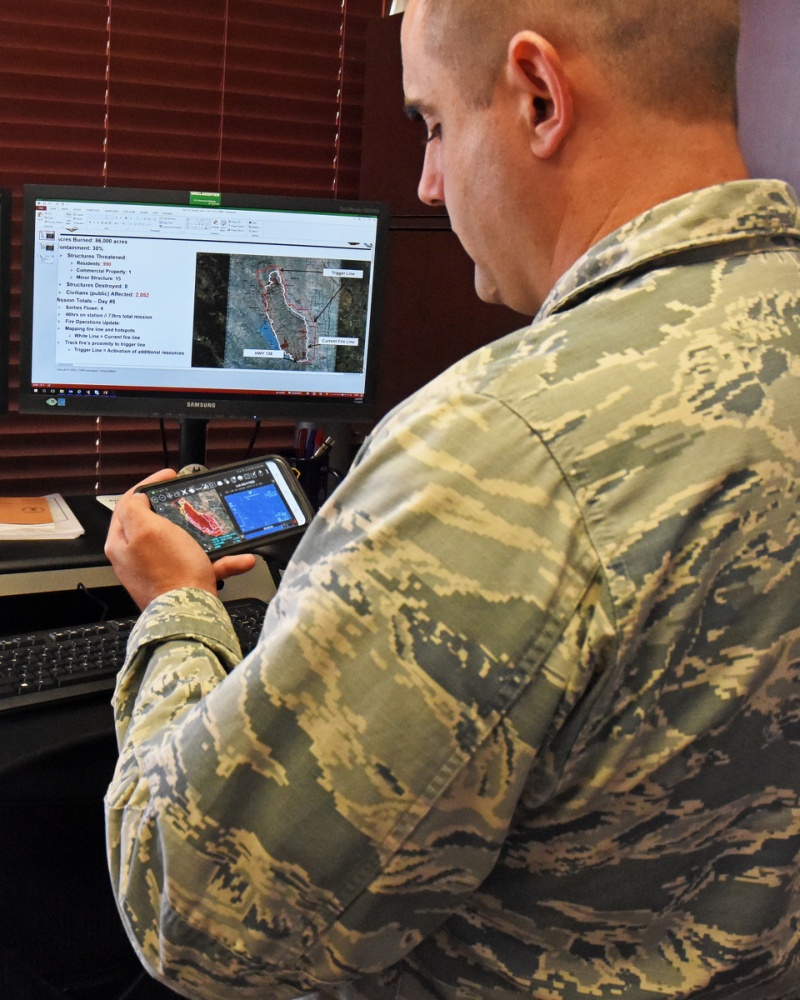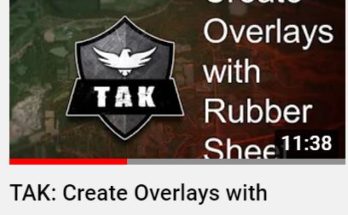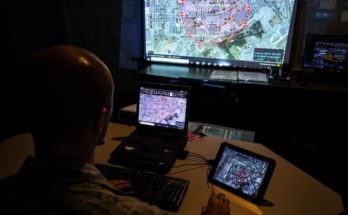From DVIDS:

Photo By Master Sgt. Gregory Solman | U.S. Air Force Maj. Michael Baird, military lead at the Hap Arnold Innovation Center of the 163d Attack Wing, California Air National Guard, at March Air Reserve Base, California, demonstrates a handheld Android Tactical Assault Kit (ATAK) device, July 14, 2018. ATAK devices were implemented by the Innovation Center to aid state agencies battling wildfires in Northern California. (U.S. Air National Guard photo by Tech. Sgt. [CA] Gregory Solman) see less | View Image Page
MARCH AIR RESERVE BASE, Calif. –The 163d Attack Wing’s Hap Arnold Innovation Center (HAIC) has turned California wildfires into a crucible of American ingenuity. The brainstorming center of the California Air National Guard wing, which flies MQ-9 Reaper remotely piloted aircraft (RPA) from March Air Reserve Base, enabled technology forged in combat theatres to work for fighting wildfires and other homefront emergencies. Empowered by HAF/A2Q—the Air Force innovation office—and California Joint Forces Headquarters, HAIC’s breakthrough in configuring handheld devices to its purpose-built network heralds a new era for air-and-ground networked domestic operations (DOMOPS).
Among the first major blazes of the state’s devastating fire season, the (Yolo) County and Klamathon events erupted, poignantly, in the days before and after the 4th of July. The wing responded with a unique service for the California Department of Forestry and Fire Protection (CAL FIRE) that it had pioneered in 2013 on the Rim Fire in the Stanislaus National Forest: 163d pilots and sensor operators guided Reapers overhead to provide a bird’s-eye view of the scene—including inaccessible terrain which, on the County fire, was practically the entire northern front of the blaze.
In support of the Thomas Fire in December 2017—at that point, the largest in California’s recorded history—the Innovation Center field tested Android Tactical Assault Kits (ATAKs), handheld devices ranging from smartphone to tablets, as a pilot program to migrate the established technology to its wildfire operations—adding a ground-component complement to what it had been doing in the air.
ATAKs, as the military-version acronym implies, had been used in combat operations for quite some time, according to U.S. Navy Lt. j.g. Douglas Witherspoon, an officer assigned to work on joint projects at the Innovation Center. The ATAK application was first developed at the Air Force Research Lab, as a solution to the confusion during the Mogadishu (“Blackhawk Down”) incident in Somalia, and has since spread beyond the military to a variety of civilian agencies.
During the County and Klamathon eruptions, Reapers mapped the fire perimeters and monitored CAL FIRE’s “trigger lines…if the fire went past red lines on a map, they wanted to know,” says Master Sgt. Kirk, an NCOIC on the operations floor at the wing’s formal training unit. “If a fire jumped the line, it would trigger other assets, even a greater response.”
Ten firefighters were issued ATAKs, allowing RPA’s to deliver its full-motion video images of the blaze from above, and streamed in high-definition video to the ATAKs: Firefighters around the perimeter could see the Reaper’s point of view in near real time, as well as the positioning of the other ATAK-equipped teammates on a split screen, represented as labeled points on a map. Firefighters could—and did—request different views from the Reaper crews and manage their critical resources directly from their ATAK devices.
The situational awareness capability of ATAK alone represents a significant advance over five-year-old methods, said Maj. Jason Flowers, wing plans officer. “During previous fires, the firefighters would have a large meeting first thing in the morning, dole out the assignments, and tell the firefighters where to go,” Flowers said. “They would come back 12 or 13 hours later, but the command-and-control element wouldn’t necessarily know until the end of the day, due to communication challenges in mountainous terrain, whether the firefighters made it to where they were supposed to be, and, in fact, sometimes they hadn’t. ATAK can show all the users on the field, at the same time, on a map.”
“The 163d is always looking to push the boundaries and establish partnerships that can expand our capabilities to increase our mission effectiveness,” said Maj. Michael Baird, HAIC military lead. “Without the HAIC’s relationship with HAF/A2Q, we don’t have ATAKs, and we wouldn’t be able to do what we do with them. Firefighters are out in the field, able to put a point on the ATAK on the ground in Yolo, and we were able to see it here in the Squadron Operation Center (SOC).”
Though it hadn’t invented ATAKs, making them work with RPA operations posed a challenge. As early as 2009, at the behest of then Col. (now Brig. Gen.) Dana Hessheimer, 163d airmen were working out solutions to distribute (then) MQ-1 Predator RPA imagery to the California National Guard’s Joint Operations Center in Sacramento, CAL FIRE, and other critical decision makers.
But the network was too slow and expensive to the point of being impractical for domestic information gathering, Witherspoon recalled. “The problem was that they’d never built the infrastructure on the unclassified-network side to support how we need to operate in the domestic operations theatre,” Baird added.
The Innovation Center team managed to shuttle the Reaper’s video to desktops on base, “but even getting it up to state headquarters was ‘kludge-y. At one point, we were sharing a screen with video running on it,” Witherspoon said. The team considered several solutions, but each lacked something in security, strength, speed, accessibility, or another necessary feature. “I knew we had to get better than this if we were going to support domestic operations and fires.”
By February 2017, HAIC was up and running, and that was the sort of problem it was designed to solve. In fact, the networking task that had been pushed down from the wing posed a clear question: Can we use a commercial ISP network with military-use-only common operating systems and repurpose them for domestic use?
The answer was somewhere in the HAF/A2Q-developed tool called SIRIS (Surveillance Intelligence Reconnaissance Information System), the connection between the SOC and ATAK devices in the field.
And the solution from the Innovation Center proved itself no sooner had the ribbon been cut on HAIC: A potential break in the Oroville Dam threatened an entire town, some 200,000 residents were evacuated, and a 163d Reaper circled above. “At that point, we could take any air asset that could push down full-motion video, any sort of data, and grab it line-of-sight, and make it available to anybody given access,” remembered Tech. Sgt. Danny Rafferty, IT specialist, who was awarded the Meritorious Service Medal for his work at the Innovation Center.
By the time of Hurricane Harvey, in August 2017, word had gotten around. “Our TAG [The Adjutant General of California, Maj. Gen. David S. Baldwin] tasked us to assist Texas, knowing that they would not be able to fly any IAA [Incident Awareness and Assessment] assets during the hurricanes,” Rafferty recalled. “We knew all communications would be down, which is pretty normal during hurricanes. But we had showcased our secured/unclassified network, and everyone knew our capabilities from previous missions earlier that year.”
Rafferty and Tech. Sgt. Matthew Gibbs, lead systems engineer on the project, were tasked to run their network during Hurricane Harvey from HAIC in California. “The unclassified environment allows other agencies to work with us—FEMA, CAL OES, CAL FIRE, Department of Homeland Security—anybody that responds to a natural disaster can look at the data,” Rafferty said.
When the 163d’s Reapers hovered over the Napa-Sonoma fires in October 2017, end-users had started to notice that the status quo had changed, Rafferty recalled. “It was us, at the Innovation Center, serving up a buffet of tools: SIRIS, the common operating picture, Jagwire, the ability to ingest a feed into the net from local assets or line of sight concept; ATAK, taking video [via our network] and being able to disseminate it out.”
Now that ATAK has been successfully demonstrated to work on HAIC’s network, the possibilities for future of domestic operations widen considerably, Rafferty and Gibbs agreed. “Imagine a disaster that makes it difficult for a drill-status guardsmen to go into a home unit,” Rafferty suggested. “If they have an ATAK, they’re ready to go. They don’t have to report here to start providing information that they are seeing.”
Baird contended that the success of the Innovation Center’s trial by fire fulfills the vision of the Air Force Chief of Staff, General Goldfein. “The Hap Arnold Innovation Center is a prime example of enabling innovation at the squadron level,” Baird said. “We have airmen at the mission’s edge identifying mission critical limitations, who are empowered and given the resources to develop a solution that will affect not only the 163d, but how the National Guard supports domestic operations.”
“The future is now,” Baird continued. “The network and suite of tools we have developed for DOMOPS is ground breaking, but this is only the tip of the iceberg of the capabilities the HAIC can provide by enabling innovation at the lowest levels.”


